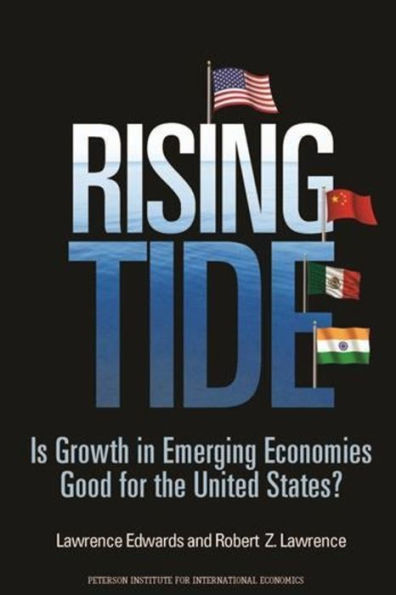
Rising Tide: Is Growth in Emerging Economies Good for the United States?
176
Rising Tide: Is Growth in Emerging Economies Good for the United States?
176Paperback(New Edition)
-
PICK UP IN STORECheck Availability at Nearby Stores
Available within 2 business hours
Related collections and offers
Overview
In this study, Lawrence Edwards and Robert Z. Lawrence confront these fears through an extensive survey of the empirical literature and in depth analyses of the evidence. Their conclusions contradict several popular theories about the negative impact of US trade with developing countries. They find considerable evidence that while adjusting to foreign economic growth does present America with challenges, growth in emerging-market economies is in America's economic interest. It is hard, of course, for Americans to become used to a world in which the preponderance of economic activity is located in Asia. But one of America's great strengths is its adaptability. And if it does adapt, the American economy can be buoyed by that rising tide.

Product Details
| ISBN-13: | 9780881325003 |
|---|---|
| Publisher: | Peterson Institute for International Economics |
| Publication date: | 10/15/2010 |
| Edition description: | New Edition |
| Pages: | 176 |
| Sales rank: | 855,123 |
| Product dimensions: | 5.90(w) x 8.90(h) x 1.10(d) |
| Age Range: | 18 Years |
About the Author
Lawrence Edwards is a professor at the School of Economics, University of Cape Town, and research associate at the South African Labor and Development Research Unit (SALDRU) and Policy Research on International Services and Manufacturing (PRISM). His research interests focus on the effects of international trade on labor, determinants of trade flows, and trade policy.
Table of Contents
Preface xiii
Acknowledgments xix
Introduction 1
The Public's Concerns: Jobs 4
The Economists' Concerns: Welfare and Inequality 6
Study Findings 10
Study Outline 13
Scope of the Study 26
I Trade and Jobs: Exploring the Public's Concerns 29
1 Trade and (Total) Jobs 33
Arithmetic versus Behavior 34
Trade Agreements 42
Fiscal and Macroeconomic Policies 42
2 Imports and Lost Jobs and Wages 45
Imports and Gross Job Losses 47
Imports and Specific Wages 52
Implications 54
3 "Good Jobs"-Trade and US Manufacturing Employment 57
Closing of the US Labor Market 60
Manufacturing Employment: Tracking the Decline 63
Explaining Deindustrialization 67
Did the Manufacturing Trade Deficit Play a Large Role in Manufacturing Employment Losses? 79
Offshoring 84
Conclusions 84
II Competitiveness, Welfare, and Inequality: Exploring the Concerns With Detailed Data 87
4 Do Developed and Developing Countries Compete Head to Head? 91
Export Overlap 94
Technological Sophistication 103
Price Dispersion by Technology Classification 115
Intermediate Inputs versus Finished Products 118
The Question of Quality 120
Conclusions 122
Appendix 4A Quality Measurement 125
III Trade and Welfare: Exploring the Economists' Concerns 133
5 Developing-Country Growth and US Welfare 135
Theory, Foreign Growth, and Welfare 136
Hicks' Conjecture 139
Gains from US Trade with Emerging-Market Economies 149
6 US Welfare and the Trade Balance 153
The Trade Deficit 154
Correcting for the Trade Deficit 157
Graphical Analysis of the Relationship between Terms of Trade and Trade Balance 162
Welfare 165
7 Oil 171
Oil Price Fluctuations and the US Economy 172
Explaining the Recent Oil Price Boom 174
The Future 179
Conclusions 183
IV Trade and Wage Inequality: Exploring the Economists' Concerns 185
8 Developing-Country Trade and US Wages: Theoretical Perspectives 187
Restrictive Assumptions: Nonspecialization and Perfect Labor Mobility 190
Other Theories 195
9 Trade and the US Skill Premium 199
Recent Developments 202
Studies of Recent Data 210
Analysis of Prices 212
Conclusions 218
Appendix 9A Are Developing-Country Manufactured Imports Intensive in Unskilled Labor? 221
Appendix 9B Measurement Error in the Price Data 227
Appendix 9C Isolating the Role of Trade with Mandated Wage Regressions 231
10 Conclusions and Policy Implications 235
What Do These Findings Imply for Policy? 238
Conclusions 251
References 253
Index 269
Tables
3.1 Share of employment in manufacturing, 1973-2010 67
3.2 Growth of employment, output, and labor productivity, 1960-2007 69
3.3 Manufacturing employment content of the manufacturing trade deficit, 1990, 2000, and 2010 83
4.1 Export similarity indices for manufactured goods, ranked by similarity with high-income OECD countries in 2006 98
4.2 Cumulative shares of manufactured exports to the United States relative to China, 2006 98
4.3 Average unit values relative to OECD exports to the United States and aggregate US exports, ranked by price relative to the OECD countries in 2006 101
4.4 Lall (2000) technology classification of exports 105
4.5 Share structure of US manufacturing imports by technology classification, 1990 and 2006 106
